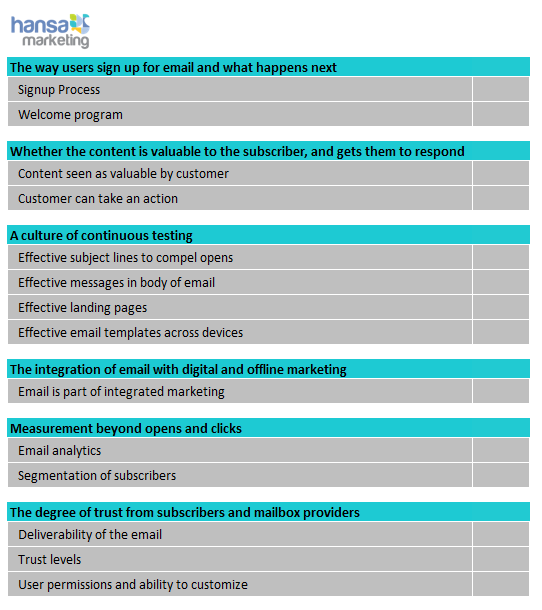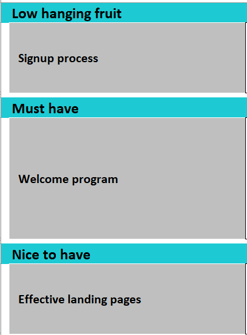I’ll bet people give you good ideas all the time. In email marketing, there is no shortage. I’m guilty myself – always eager to share a best practice or example. I love the thought leadership from TowerData ; and idea starters from really good emails. Problem is: all these great ideas seem promising and brilliant. So what.
How do you put great ideas in order? Which ones will be important?
You need a scorecard
I want to share my scorecard with you. It is a companion piece to our best practices guide. But it can be used to organize any marketing problem and impose structure to all the great ideas you read about in blogs and hear about from colleagues. For email best practices, it looks like this:

But notice there is a place for scoring and prioritizing left blank. That’s the magic.
Go ahead and open up the scorecard and see how it works. Imagine you are comparing ideas in this format. For each idea, what is the:
- Current state. What are you doing today? Be honest. Give yourself a score
- Envision an ideal state. What is your plan for tomorrow? What problem will the idea solve?
Look at the gap between the two. Is this gap large or small? You just did a simple gap analysis. And that brings you to the fun part:
- What is the priority? Is closing the gap important? Does it align with a strategy, or is it nice to have? Give this a score as well (1 is low priority; 3 is high)
- What is the level of effort? How much effort and investment will be required to close the gap? Big deal? Little deal? Your guess is a good starting point, but this can also start a conversation with your tech partners
That’s it: you did 90% of the work just by fitting ideas into a scorecard. But wait there’s more! (I couldn’t resist that old slogan)
Make the scorecard actionable
The reward for doing this in a scorecard format is your ability to sort the final result into a roadmap. By sorting high impact ideas with low effort to the top, you will notice …
The roadmap reveals low hanging fruit – ideas you can implement that are have high impact and low level of effort
By contrast, relegate the low impact/high effort ideas to the bottom.
The roadmap reveals nice to haves – ideas, while good, that are not the priority. They may be terrific ideas, but they are not strategic (aligned with what you need to do), nor are they worth the investment
I put an example on a separate tab in the scorecard. If you’re following along, the illustration shows that the signup process idea comes before the welcome program which comes before the landing page optimization

You want to get fancy? Create a weighted scorecard with points to get allocated. When we do consulting work we always add a “bang per buck” ratio, especially when evaluating software or services. What about a business case, business requirements? How will you measure success?
What does success look like?
Expert email marketers are quick to add columns in the scorecard about measurement. These can be milestones, like being able to view all email campaigns in one place. Maybe a technology success (e.g., getting emails into inboxes no longer than 1 minute after an Order, Shipment, Password Reset Request, etc). My favorite KPIs go beyond email performance and into customer metrics (increasing lifetime spend, reducing attrition, promoting customer referrals). The business outcomes.
People look to Marketing for leadership and scorecards have always been a trusted tool for prioritizing what Ii recommend. But the scorecard is just a tool – your value-add to the ideas is the magic.
Most of all, how will you be able to recognize your success?
 Roy Wollen has led some of the top marketers in industries such as travel, financial services, b2b and multi-channel retail. Roy is a consultant at heart and solves client problems using marketing technology and analytics. Roy is President at Hansa Marketing Services and an adjunct lecturer at Northwestern University, where he teaches Digital Analytics.
Roy Wollen has led some of the top marketers in industries such as travel, financial services, b2b and multi-channel retail. Roy is a consultant at heart and solves client problems using marketing technology and analytics. Roy is President at Hansa Marketing Services and an adjunct lecturer at Northwestern University, where he teaches Digital Analytics.
This article originally appeared in Hansa Marketing. Photo by Nathan Dumlao on Unsplash.












